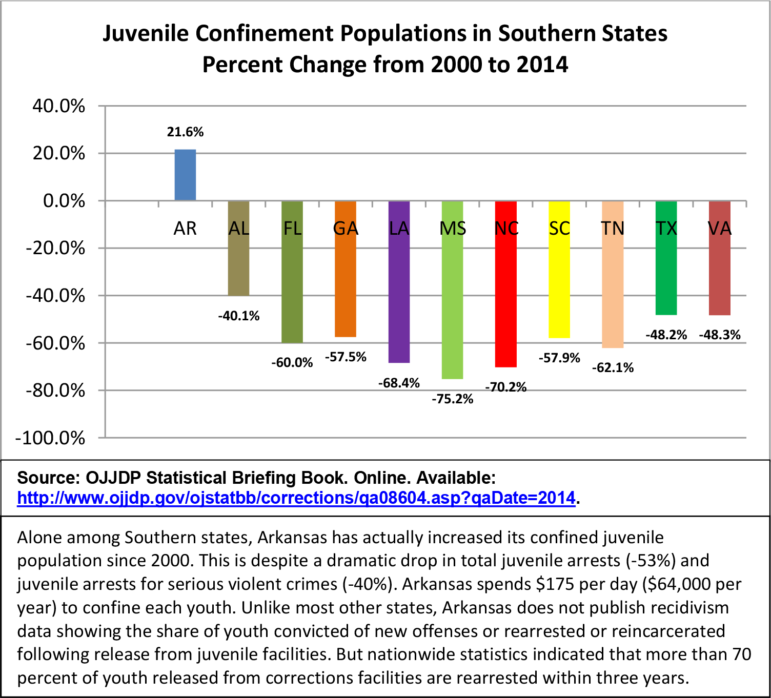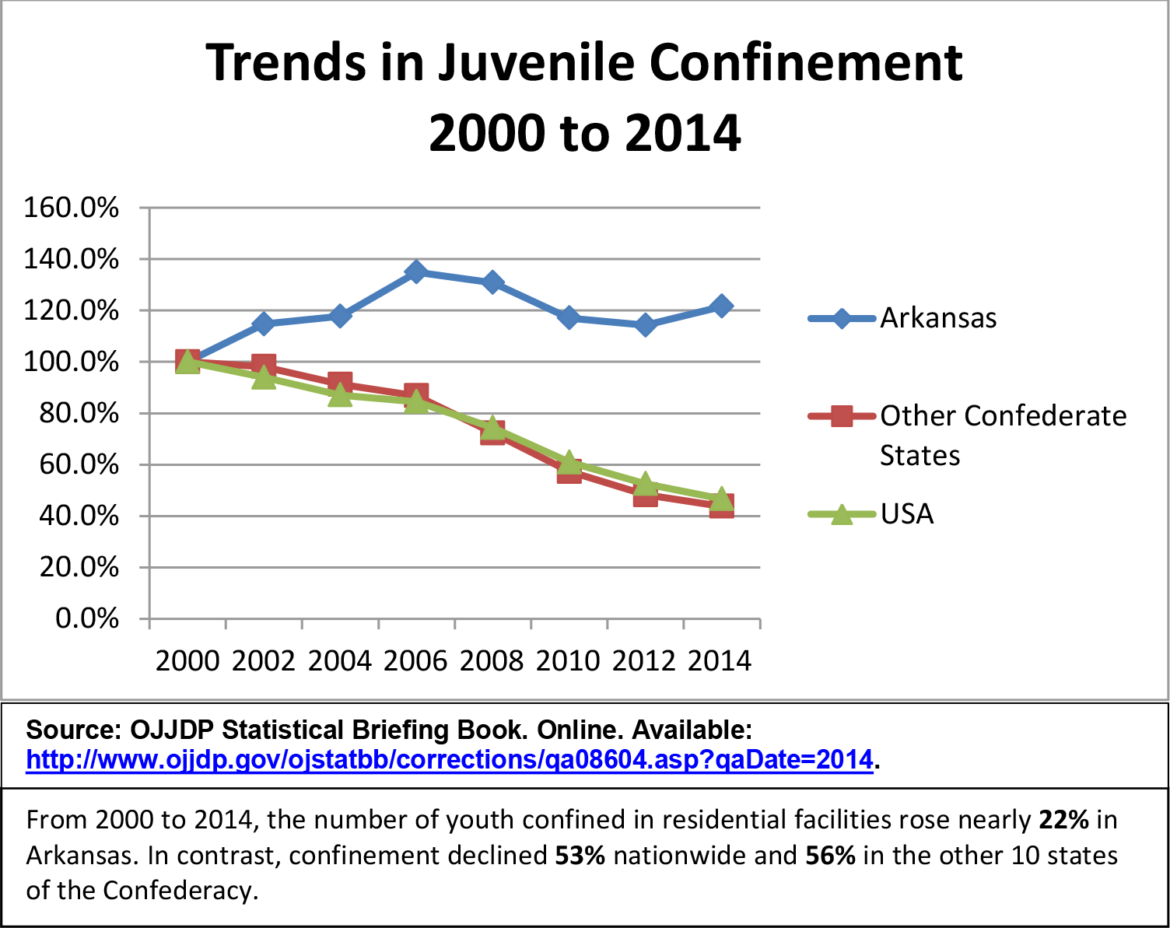
Over the past two years, Arkansas’ juvenile justice system has burst into the news repeatedly — and for all the wrong reasons. In August 2014, the Disability Rights Center documented alarming conditions in the state’s largest juvenile correctional facility. In 2015, the Arkansas Democrat-Gazette documented the state’s continuing penchant for jailing children brought to court for status offenses — misbehaviors like skipping school or running away from home that are not illegal for adults — contradicting an overwhelming consensus in the field.
This year, Republican Sen. Tom Cotton of Arkansas has made news by single-handedly derailing reauthorization of the federal Juvenile Justice and Delinquency Prevention Act in protest against legislative language that would tighten the federal government’s prohibition on confining status offenders.
Meanwhile, even as juvenile incarceration has been plummeting nationwide, Arkansas has increased the number of youth committed to state custody for two straight years despite a continuing drop in their arrests.
Why is Arkansas apparently moving backwards when many of its peers, including several deep red Southern states, have turned a corner by embracing more humane and evidence-based approaches to juvenile justice?
The problem stems largely from the outsized influence of Arkansas’ unique network of service provider agencies, experts and advocates told me.
These agencies are not the kinds of scandal-plagued for-profit prison corporations often (and rightfully) pilloried in the press. Rather, they are nonprofit, community-based and widely respected, with a long history of caring for troubled children.
Most were created in the 1970s after passage of the Runaway Youth Act made federal funds available for programs to assist wayward youth. Initially, the organizations struggled. But that began changing in the late 1970s and early ‘80s after they undertook training on how they could band together and expand their influence.
In later years, the providers put politically connected leaders on their boards and branched out to serve youth in the delinquency system. After forming the Arkansas Youth Service Providers Association, they negotiated standard contracts with the Division of Youth Services (DYS) to pay them for community-based services, and some opened residential facilities as well. Rather than fight each other for funding, the 13 providers agreed to carve the state into pieces, and each became the sole recipient of DYS contracts in its given territory.
Though no one I spoke with accused the providers of corruption, or even bad will, several observers described them as obstacles to reform. “The providers have become very entrenched,” explained Paul Kelly, who once ran a provider agency and served as the first director of the providers association.
“They very seldom have anyone competing with them,” said Kelly, who now works at Arkansas Advocates for Children and Families. The providers have fought “any really meaningful accountability for the impact of their services,” he added.
Mickey Yeager, a data analyst at DYS from 2009 to 2014, was more blunt: “The providers in Arkansas are very powerful. They basically do what they want.”
Ron Angel, who served as DYS director from 2007 to 2013, recalls his first meeting with the providers. “They told me: They have been here for 30 years … They knew what was needed, and there was nothing that could be brought in that would work any better than what they were doing at the time.”

The message was jarring, because DYS was then facing a lawsuit over abusive conditions in its main juvenile facility, and because just 15 percent of the youth committed to state custody in 2007 had committed a serious violent felony, while 42 percent had committed only misdemeanors.
At DYS, Angel overhauled the state’s largest facility, and sought to reduce the number of low-risk youth in residential custody while expanding and improving community programs. He set a goal for each judicial district in the state to reduce commitments by at least 10 percent per year, and he created an incentive fund to support new programming in the districts where commitments declined 20 percent.
The changes made a difference. From 2007 to 2012, the number of youth committed to state custody fell. So did the average population in state youth facilities and the share of committed youth who had been adjudicated for misdemeanors. But the improvements were modest.
In early 2013, Angel and his allies crafted a legislative proposal to create local Community Youth Services Boards and engage entire communities, not just service providers, in determining the right mix of programs for court-involved youth.
The bill was throttled, however, when providers worked their contacts in the Legislature and mounted a lobbying campaign against it.
John Furness, executive director of Comprehensive Juvenile Services in Fort Smith, Arkansas, is unapologetic about killing Angel’s proposal. “I saw that as a complete dismantling of the very established provider network that has been in place for many years and does good work,” Furness told me. “I thought it was a bad bill, and we spoke out against it.”
Within weeks, Angel tendered his resignation and retired.
The provider association’s fingerprints can also be seen in the dearth of meaningful data analysis in Arkansas’ juvenile system and the frequent leadership turnover at DYS.
Before 2007, DYS made little effort to analyze its population, or determine what worked and didn’t work. “The data was there. You just had to pull it,” recalled Yeager, the data specialist. “But no one was digging through it.”
When Angel tried to make service providers report details on the services they offered and their results, “you would have thought we had asked for their firstborn child,” Angel recalled. “How can you base your treatment if you don’t have standards where you can measure what’s being successful and what’s not?”
The providers “fought us every step of the way,” Yeager added. “Ron was called to the capital several times … because he was trying to track the performance of the providers.”
That dynamic wasn’t new, Kelly said: “I have sat back and watched [the providers] make life miserable for one DYS director after another, just because they propose a different way of doing things or make life in any way uncomfortable.”
Angel’s greatest accomplishment at DYS may have been simply lasting for six years. He arrived as the agency’s ninth new director in 12 years. Since his retirement, DYS has cycled through two more directors. In April, the latest one abruptly resigned and the agency is now led by an interim appointee.
Despite these impediments, momentum for reform is once again building in Arkansas. Promising models for enhanced risk and need assessments, detention reform and improved juvenile probation practice are being tested around the state. The state’s court system is improving juvenile data collection and has established an active juvenile justice reform subcommittee.
Plus, a youth justice reform board appointed by Gov. Asa Hutchison appears ready to support a multimillion-dollar incentive fund to reduce the number of kids sentenced to state custody, reviving Angel’s strategy. Meanwhile, many of the state’s juvenile judges are abandoning old-school, law-and-order orthodoxy and embracing more therapeutic and targeted approaches.
Across Arkansas, judges and other local leaders are growing more and more familiar with the dramatic advances the juvenile justice field has made in recent years, more and more eager to embrace what works — as their peers have done in other states.
Amid this groundswell, providers will face increasing pressure to adapt new practices, collect better data and measure performance. If they continue to resist, the providers will likely squander their credibility and lose their cherished place at the heart of the Arkansas system.
The pull of progress is simply too strong.
Dick Mendel is an independent writer and editor on juvenile justice and other youth, poverty and community development issues. He has written nationally disseminated reports for the Annie E. Casey Foundation and others and has also written articles for The Atlantic, Washington Monthly, Legal Times, Raleigh News and Observer and Baltimore Sun.

So you REPOST this poorly investigated, full of inaccuracies and assumptions “analysis” piece again over a week later? Why is that exactly? Is this original one still posted so anyone caring to read a fuller spectrum of viewpoints (because this article sure does not provide that) might care to do so? I certainly hope so; if not, or if you do not retrieve the comments from the original posting and copy here, I am cancelling my email subscription to the JJIE post haste as I have zero faith in you as an advocate of and promoter of reform in the Juvenile Justice System.
Same old bs in all DHS departments. Controlled by providers who are doing it thru lobbyist. Leg. fails to do oversight, just follow lobbyist. More cost effective to disband leg. and let lobbyist run gov.